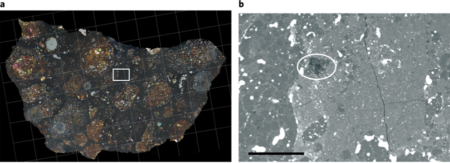Scientists studying a primitive meteorite found in Antarctica came across an unusual feature deep inside—a tiny carbon-rich pocket. Although the meteorite’s primary mineralogy suggested it broke off of an asteroid formed just beyond Jupiter, the pocket’s high carbon content pointed to more distant origins in the icy outer solar system. To decode the chemical signature and the meteorite’s history, the team relied on the analytical capabilities at the Advanced Light Source (ALS).
The researchers used the scanning transmission x-ray microscope (STXM) at ALS Beamline 5.3.2.2 to perform x-ray absorption near-edge structure (XANES) measurements to identify differences in organic bonding within the pocket compared with the carbon in the rest of the meteorite. The results revealed that the organic matter in the pocket was chemically distinct from the surrounding matrix, had lower oxygen bonding, and featured other hallmarks more aligned with previously studied interplanetary dust particles and micrometeorites thought to have originated from comets in the outer solar system.
Contrary to previously held theories, these findings provide the first direct evidence that large pieces from the outer solar system entered the inner solar system at an early time, as asteroids were forming and before planets existed. The carbon-rich cometary material, still in ice form, may have mixed with the asteroid material and become embedded and preserved in the asteroid as it was forming. When the meteorite broke off of the asteroid, the surrounding material protected the pristine cometary material from the atmosphere as it fell to Earth.
These findings suggest that other meteorites may retain the unique chemical signatures of primitive particles and hold the potential for unlocking more clues about the early solar system.

L.R. Nittler, R.M. Stroud, J.M. Trigo-Rodríguez, B.T. De Gregorio, C.M. O’D. Alexander, J. Davidson, C.E. Moyano-Cambero, and S. Tanbakouei, “A cometary building block in a primitive asteroidal meteorite,” Nat. Astron. (2019), doi:10.1038/s41550-019-0737-8.